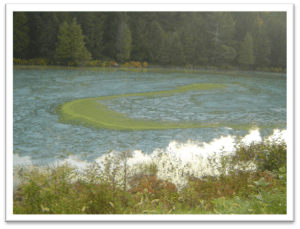An Extra Bit of Colour in Your Lake?
If you are noticing more algae on your lake this summer, you are not alone. Throughout Muskoka, there seems to be an increase in the number of algae blooms this year. The relationship between algae, algal blooms and water quality is complicated. However, it is important to understand that the presence of algae in your lake does not necessarily indicate reduced water quality, but it can be the starting point for a larger problem in the future.
What are Algae?
Algae are tiny free-floating or attached plants found in lakes and rivers. They contain chlorophyll and carry out photosynthesis.
Algae form the base of most aquatic food chains and are a valuable and critical component of a healthy aquatic environment. The types of algae found in Muskoka include green, brown, yellow and, of course, blue-green algae.
Algae require nutrients and sunlight for growth and the amount of available phosphorus and nitrogen will limit algal growth in a lake.
In addition to the concentration of nutrients in the water and the amount of sunlight that penetrates the water, other environmental factors that determine the type and amount of algae in your lake are:
- Water temperature;
- The physical removal of algae as it is flushed downstream;
- Grazing on the algae by microscopic organisms and fish;
- Parasitism by bacteria and fungi; and
- Competition from aquatic plants for nutrients and sunlight.
Phosphorus and Algae
Reasonable levels of phosphorus are required to help drive aquatic systems. It is a valuable nutrient that promotes plant growth and forms the base of food chains in ponds, streams, lakes and rivers.
However, nutrient enrichment of our lakes can lead to algae blooms and eutrophication. Excessive algal growth can destroy the appearance of water, cause unpleasant tastes or odours, reduce clarity, and colour the lake a vivid green, brown or yellow.
Natural sources of phosphorus include wetlands and the atmosphere, while man-made sources include:
- Urban and agricultural runoff
- Sewage discharges and septic tank seepage
- Eroded streambanks
- Fertilizer runoff and detergent wastes
While little can be done to reduce the nutrients entering your lake from natural sources, reducing the nutrients from man-made sources can usually prevent excessive algae growth in the future.
Algal Blooms
Excessive growth of one or more species of algae is termed a “bloom”. Algal blooms can happen at any time of the year, with summer algal blooms usually occurring after calm, hot weather when the water gets warm.
Blooms can be caused by several factors including an increase in nutrients; just as fertilizing a lawn makes the grass grow faster.
In other instances, something may change in the environment to favour one species of algae over another, leading to a population explosion. This environmental change can be related to the water quality, temperature, nutrients, sunlight, or other factors.
One of the most serious consequences of an algae bloom occurs when the bloom dies. As algae die, they sink to the bottom of the lake and decompose, depleting oxygen levels. The depletion of oxygen in the bottom layer of the lake can free phosphorus trapped in the sediments and reduce the amount of oxygen available for the survival of other aquatic organisms, including fish.
Blue-green Algae
Blue-green algae, or cyanobacteria, are actually photosynthesizing bacteria, not plants. Blue-green algae are commonly found in lakes and ponds.

A blue-green algae bloom occurred on Three Mile Lake in 2005 (photo by Jamie Delaney).
Some types of blue-green algae produce toxins while others do not. The only way to determine if a sample of blue-green algae contains species capable of producing toxins is to analyze the sample in the lab.
Blue-green algae blooms are likely to occur during sunny, calm weather when high concentrations of nutrients are present in water. Fresh blooms may smell like fresh-cut grass, while older blooms may smell like garbage. When the algae die and decompose, toxins may be released in those species that produce them. Symptoms from drinking water contaminated with blue-green algae include headaches, fever, dizziness, diarrhea, abdominal pain or stomach cramps, sore throat, nausea and/or vomiting.
Blue-green algae have several characteristics that enable them to out-compete other species of algae, including:
- The ability to adjust their buoyancy so they can float or sink depending on light conditions and nutrient supply.
- Using nitrogen fixation to maintain high rates of growth when other forms of nitrogen are depleted.
- They are less favoured by predators than green algae because they produce chemicals that make them ‘taste bad’.
Why Algal Blooms Now?
An increase in total phosphorus increases the probability that an algae bloom will occur. However, this is not the only factor and algal blooms can occur sporadically in lakes that don’t have elevated levels of nutrients.
Therefore, increased levels of phosphorus cannot be relied on as the sole rationale for sporadic or individual algal blooms, and the presence of an algae bloom does NOT necessarily indicate nutrient enrichment.
This has certainly been the case throughout Muskoka this summer. Long sunny days that raise water temperatures, minor rainfall events, and very little wind all favour the growth of algae. These conditions, combined with adequate, but not necessarily elevated, levels of phosphorus, can promote algal growth, as was observed in many lakes in Muskoka this summer.
For more information about algae, please visit the Muskoka Watershed Council website at www.muskokawatershed.org/mwc or the Muskoka Water Web at www.muskokawaterweb.ca.
Past articles are available in this blog under the Watershed Notes Articles category or under Past Articles in the Resources section.
